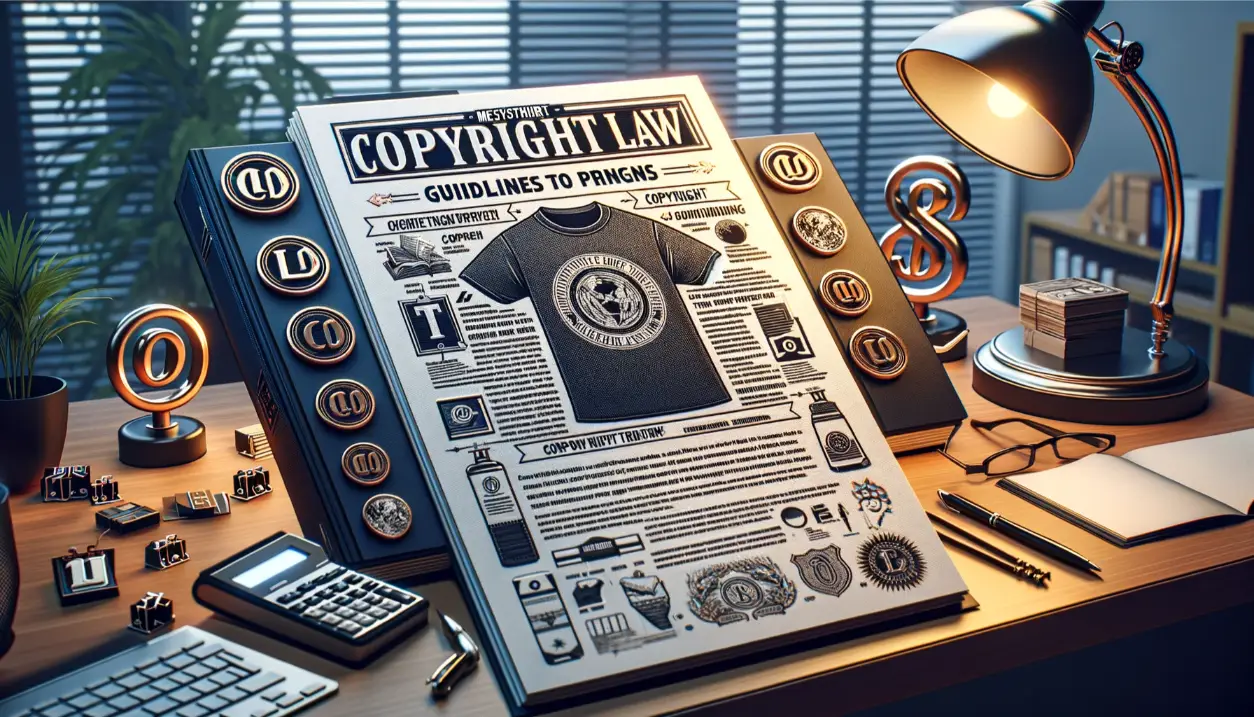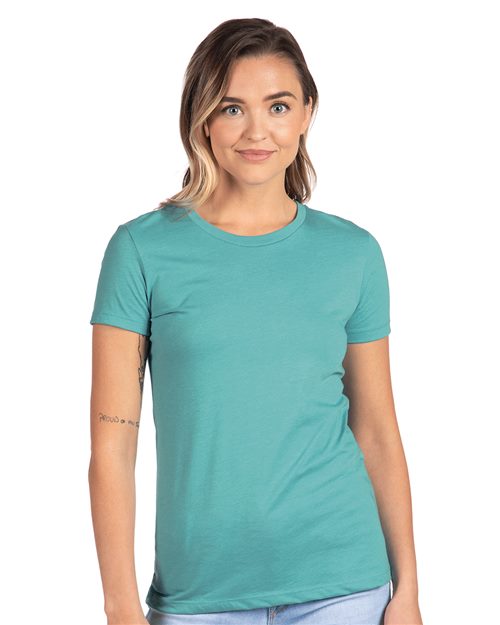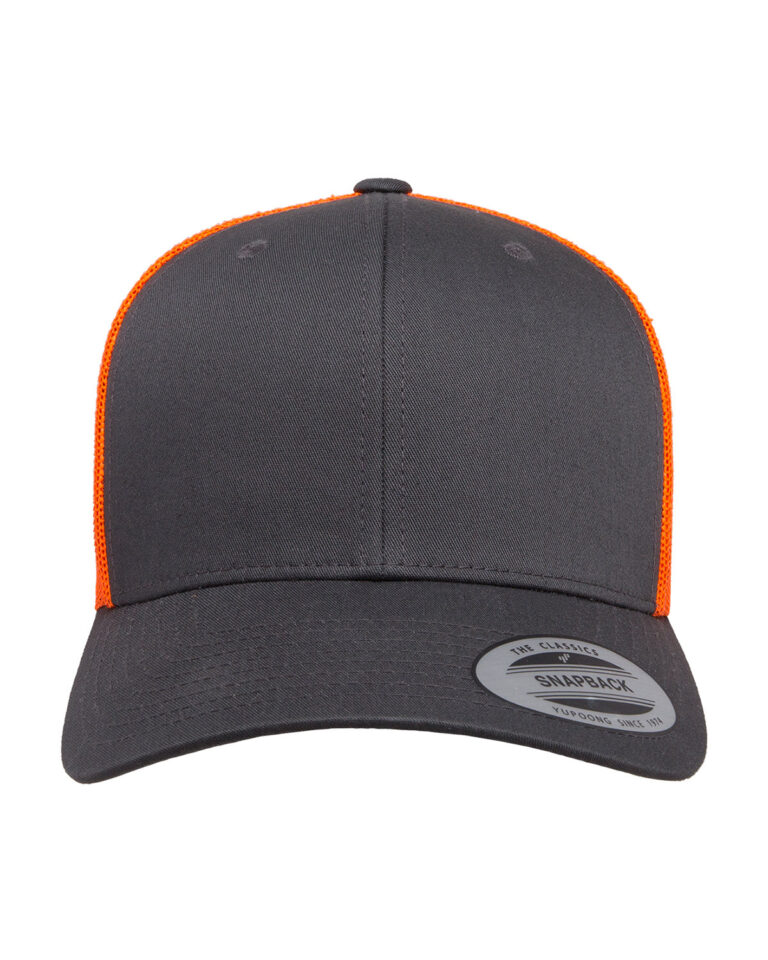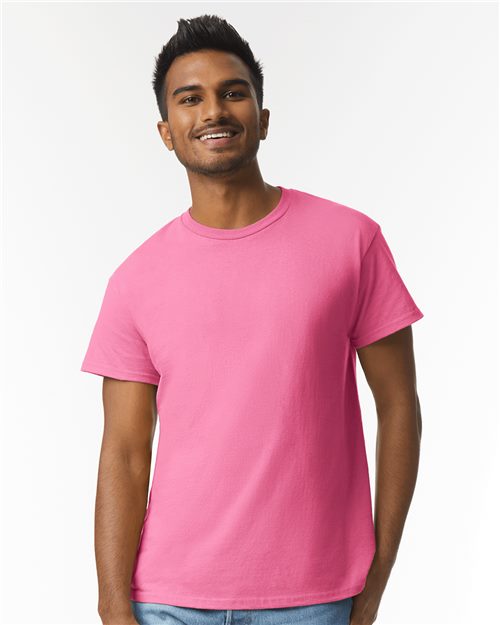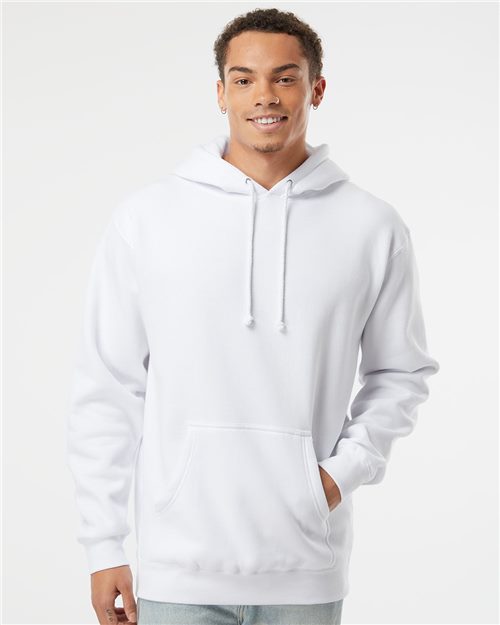Ever tried making a cool T-shirt design only to worry you might be stepping on someone’s toes, legally speaking? It’s common for folks to get tangled up in the confusion of t-shirt copyright law when they decide to print their favorite hero or catchy phrase on a shirt.
That fear is not unfounded – after all, no one wants to deal with the headache of legal troubles over something that should be fun and creative.
Did you know? Once an artist’s work has slipped into what we call the ‘public domain‘, anyone can use it without asking for permission or getting into any sort of trouble. This blog is your trusty guide through the maze of copyrights – so you’ll know just how to keep your T-shirt designs original and above board.
Stick around, and let’s dive into turning those gray areas as clear as day!
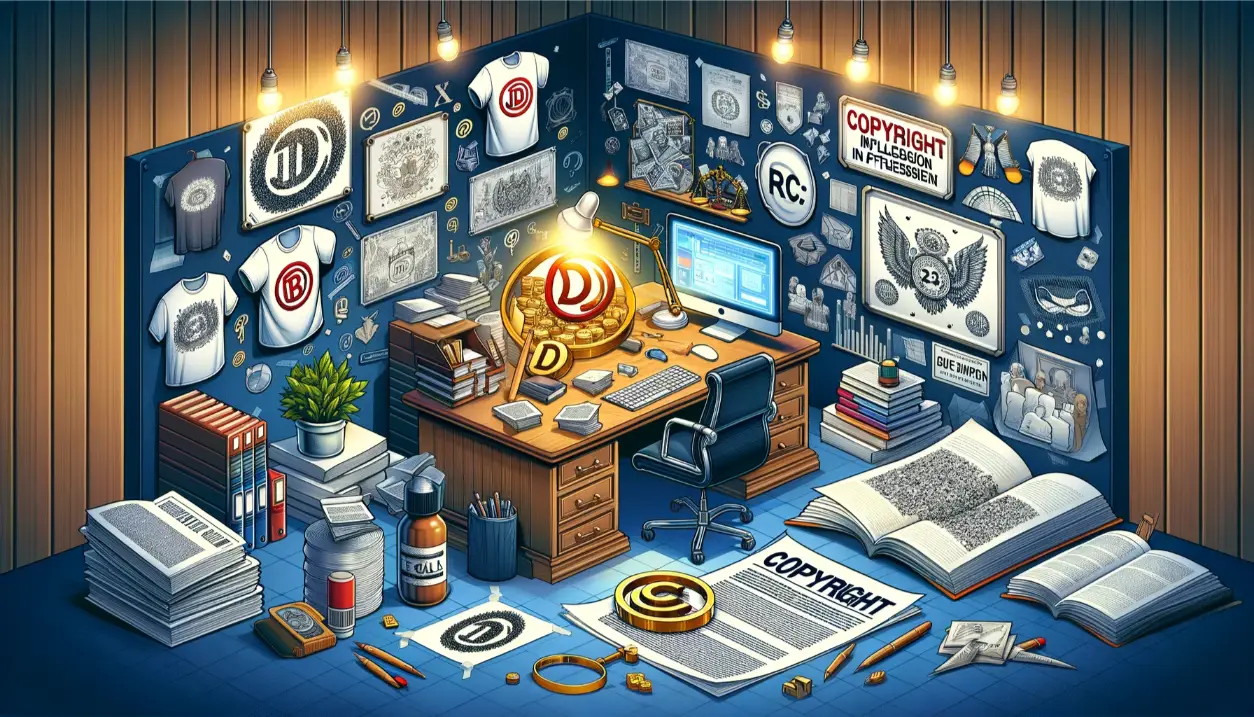
Key Takeaways
- Copyright law protects art, music, writing and more for the creator’s life plus 70 years. After that, it’s free to use.
- Public domain images and texts can be used in T-shirt designs without legal issues.
- Creating your own designs from scratch is a good way to avoid copyright infringement on T-shirts.
- Getting written permission from the owner is needed to use copyrighted work on merchandise.
- If someone uses your T-shirt design without permission, you can ask them to stop or take legal action.
Basics of T-Shirt Copyright Law
Navigating the maze of T-shirt copyright law is crucial for artists and entrepreneurs alike; understanding its foundations helps ensure your designs stay on the right side of legal creativity.
Let’s dive into the essentials, from defining copyright to distinguishing what art falls under public ownership or fair use allowances.
What is Copyright?
Copyright is a law that protects creative work. If you make something original like art, music, or writing, copyright keeps others from using it without your permission. It covers many types of work for as long as the creator lives plus 70 more years.
After that time, anyone can use the work for free.
This rule helps artists keep control over their creations. You must get permission to use someone else’s copyrighted material unless it’s in the public domain or counts as fair use.
Fair use means you can sometimes use small parts of a copyrighted work for teaching, news reporting, or making parodies without asking first.
DESIGN YOUR OWN APPAREL

What can be copyrighted?
Copyright laws protect creators and their original work. Here are things that can be copyrighted:
- Books, including novels, nonfiction works, and poetry collections. Authors get to control who makes copies or sells their written words.
- Music compositions, which cover songs, instrumentals, and even unique sounds. Musicians decide who can perform or record their tunes.
- Movies, from big blockbusters to home videos. Filmmakers have the right to choose who shows their movies.
- Artwork such as paintings, drawings, and sculptures. Artists control how their visual creations are used.
- Architectural designs for buildings and structures. Architects say who may use their blueprints.
- Choreography for dances and ballets. Choreographers dictate who performs their dance moves.
- Photographs capturing moments in time. Photographers decide who prints or shares their images.
- Computer software that runs devices and apps. Programmers keep a hold on who can use or modify what they code.
What’s in the public domain?
Public domain images and texts are not covered by copyright protection. They are free to use in your t-shirt designs. Here are some things that fall into the public domain:
- Works with expired copyrights: These are creations whose copyright has run out. For example, the writings of Shakespeare belong to everyone now.
- Content with no original creativity: Simple logos or very basic shapes often don’t get copyright in the first place.
- Items without a copyright notice: Some older works missed having a proper copyright label and so, they’re open for use by anyone.
- Creations by the US government: Pictures taken by NASA or documents produced by federal employees during their work are yours to print on tees.
- Voluntary releases: Sometimes artists want their work to be freely available, so they put it in the public domain themselves.
- Classic music and movies: You’ll find Mozart’s symphonies and silent films from early cinema ready for printing on merchandise.
What is fair use?
Moving from freely available public domain works to copyright restrictions, fair use is a key concept. Fair use lets people use copyrighted content for certain reasons without having to ask first.
These reasons include criticism, comment, news reporting, scholarship, and research. It’s part of U.S. law designed to balance the needs of both copyright holders and the public.
Fair use considers how you intend to use the material and its effect on the work’s value in the market. For example, noncommercial uses are more likely to be seen as fair. Also, parodies that mock an original work might qualify if they’re obviously different from what they’re making fun of.
But always tread carefully—fair doesn’t mean free-for-all.
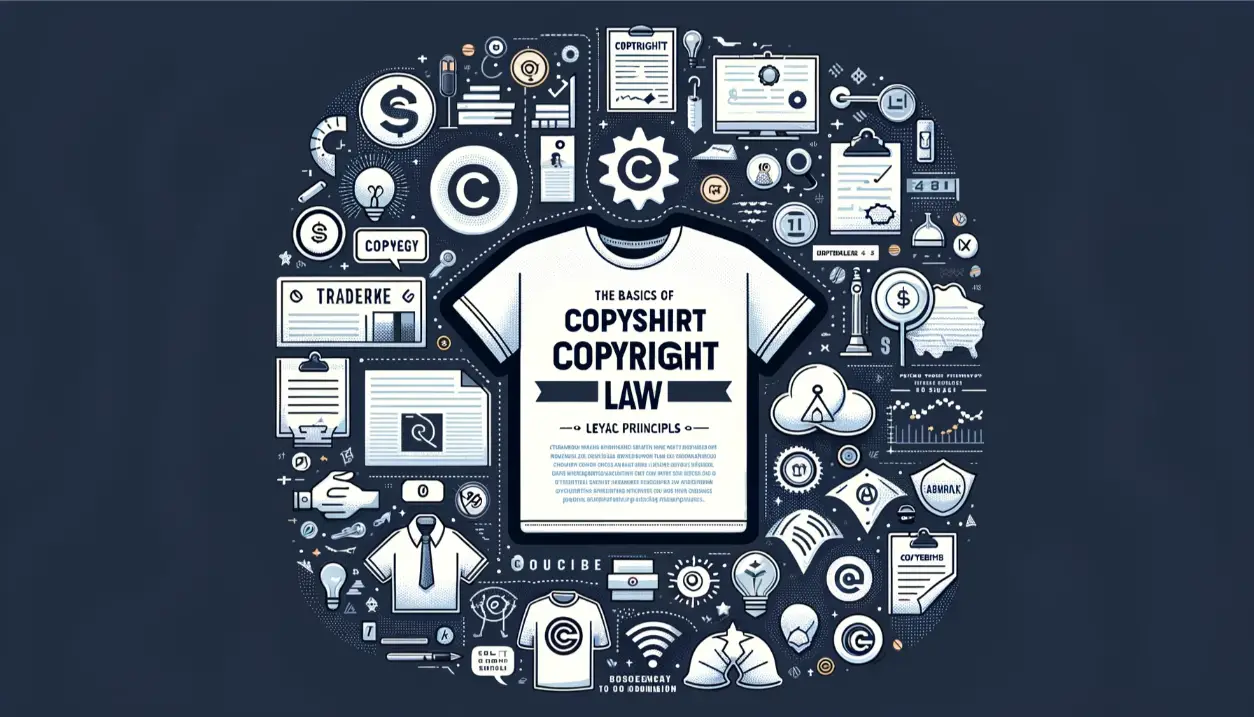
Ways to Avoid Copyright Infringement in T-Shirt Designs
Navigating the tricky waters of intellectual property can be smooth sailing when you know how to craft your T-shirt designs without stepping on copyright toes—let’s plunge into some savvy strategies that keep you in the clear.
Creating original designs from scratch
Creating your own t-shirt designs is a fun and safe way to avoid copyright infringement. Start with a blank canvas and let your imagination run wild. Use shapes, colors, and your own drawings to make something unique.
This ensures you’re not using someone else’s intellectual property without permission.
Drawing inspiration from the world around you can lead to amazing results for your t-shirts. Maybe combine an original quote with a graphic design you made yourself. You could even turn a hand-drawn sketch into a digital masterpiece.
With these custom creations, there’s no risk of breaking copyright laws or dealing with issues like DMCA notices because every part of the design comes straight from your mind and hands.
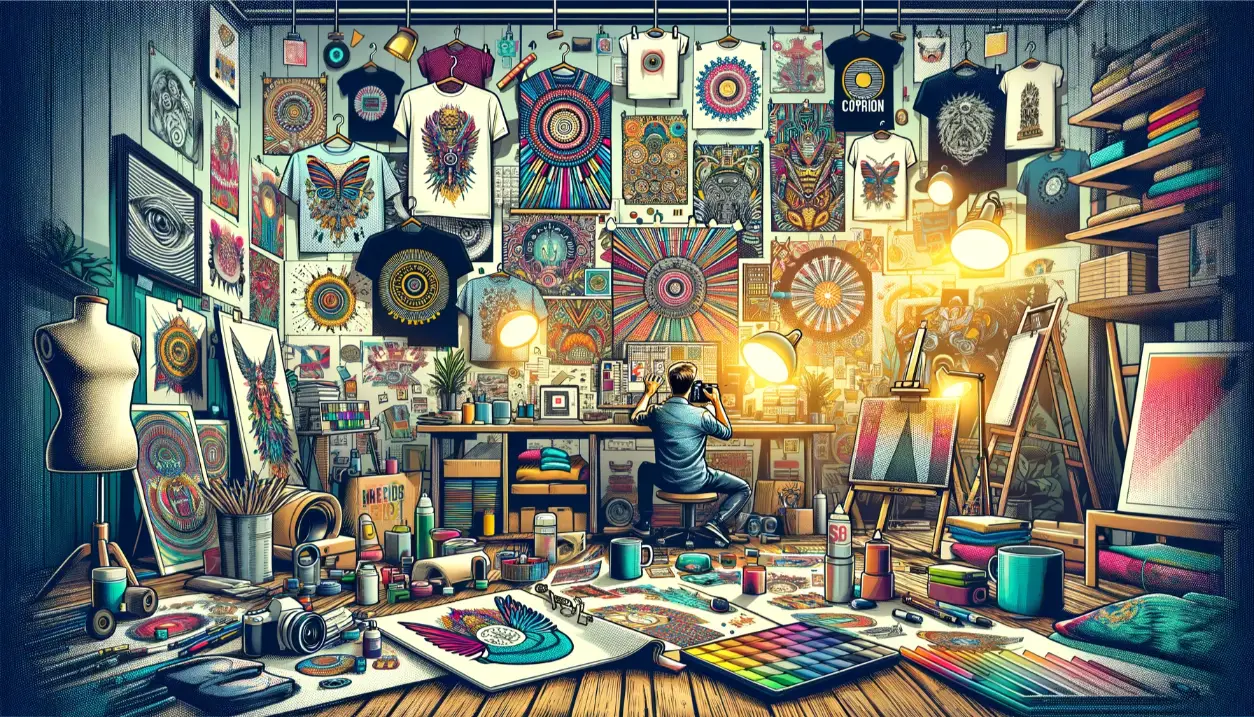
Using public domain images and texts
After crafting your own designs, another great option is using public domain images and texts. These works are not covered by copyright law anymore. This means you can use them for free on your T-shirts without asking anyone.
You’ll find plenty of these images and writings online to add a unique touch to your merchandise.
Creative Commons licenses offer different ways to use someone else’s creations legally. With these resources, you can design T-shirts that stand out and are legal at the same time.
Make sure to check that the content really is in the public domain or has a Creative Commons license before using it!
Utilizing design elements not protected by copyright
Moving from public domain images and texts, there are also design elements you can use without worrying about copyright. These include basic shapes, colors, and patterns that anyone is free to use.
For example, simple geometric shapes like circles or squares have no copyright restrictions. Also, national logos and flags fall into this category because they belong in the public sphere.
You can spice up your T-shirt designs using these elements creatively. Mix them with other images or text to make something new and unique. Just be sure not everything you’re using has copyright protection before you print it on a shirt.
This way, you stay clear of legal troubles while still making cool T-shirts!
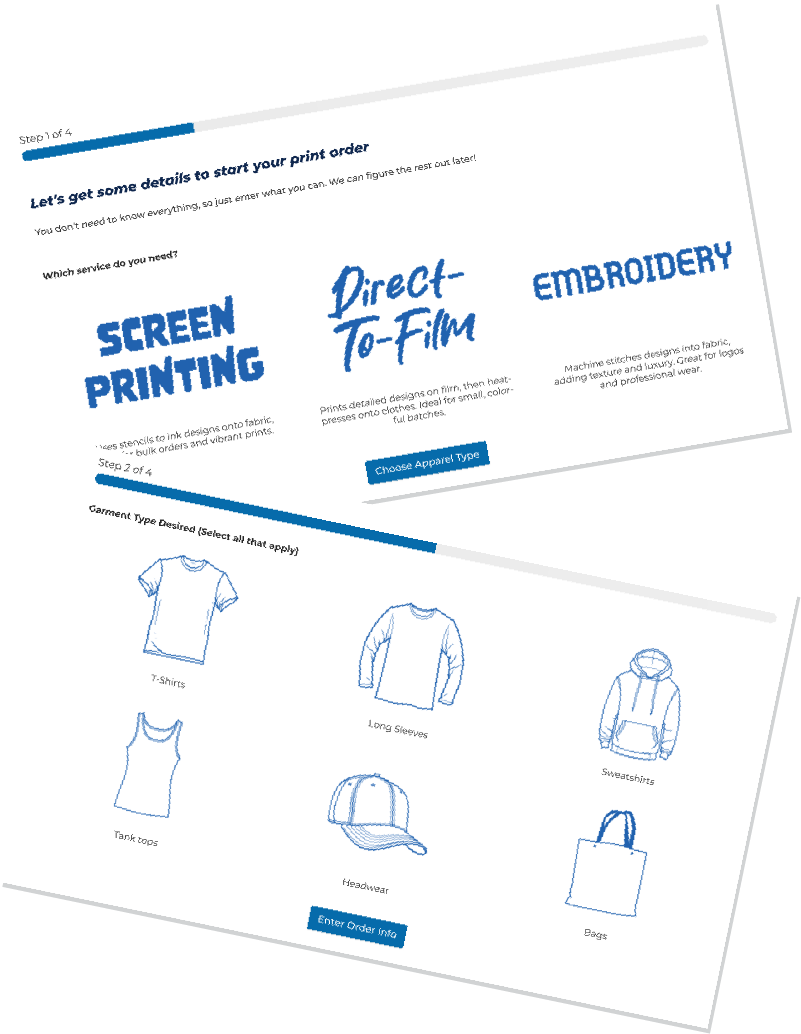
WE HELP YOU MAKE AMAZING CUSTOM PRINTED TEES & APPAREL!
CUSTOM IS COMPLICATED
WE MAKE IT EZ
Let our dedicated team help guide you! Click below to send us basic information to get your order started!
Gaining permission from the copyright owner
To use someone else’s design on your t-shirts, you need their okay. Reach out to them and ask for a yes. They might say yes for free or ask for money – this is called a licensing agreement.
Make sure everything is written down so it’s clear what you can do with the design. This keeps things legal and makes sure everyone knows who owns what.
Always get permission in writing before using branded logos or original artwork. Talk to the owner and agree on how you’ll use their work. You might pay royalties, which means giving them some of the money from your t-shirt sales.
If they say no, respect that decision and don’t use their design.
The Do’s and Don’ts of T-Shirt Copyright
Navigating the world of T-shirt copyright requires a careful balance; be knowledgeable about what sparks creativity while steering clear of legal pitfalls. Embrace the freedom to innovate, but remember that not all inspiration can be turned into an iron-on without consequence.
What you can do to create unique T-shirt designs
Get creative and make your own designs from scratch. That way, you ensure originality and steer clear of any copyright problems. Look for inspiration everywhere but draw or design everything yourself.
Use different colors, shapes, and patterns to craft a T-shirt that stands out.
Explore resources like Creative Commons for images that are free to use legally. Websites with stock images can also be helpful when you’re looking for visual elements without the copyright worry.
Always check the license to confirm that you can use it on merchandise! Try remixing these resources in new ways to create something truly unique and personal for your T-shirts.
What you cannot do to avoid infringements
Copying someone else’s art for your T-shirt is a no-go. You can’t just grab logos, quotes, or pictures of famous people and slap them on a shirt. Steer clear of using stuff like cartoons, sports team symbols, or any branding without getting a green light from the owner first.
Even those catchy memes you see all over social media could land you in hot water if they’re plastered on your merch without permission.
Designers must dodge trademark laws and copyright protections. It means staying away from Disney characters or anything Mickey Mouse-related unless you want trouble with big companies.
Don’t try to make quick cash by selling bootleg shirts either; it’s illegal downloading someone else’s work onto fabric! Always check if an image is royalty-free before using it or make sure to secure licensing agreements when needed.
And remember – no taking shortcuts by plagiarizing others’ ideas for your next great T-shirt design.
Dealing with Copyright Infringement

Discover your options when you find your unique T-shirt design has been duplicated without permission, or if you’re accused of infringing on someone else’s creative work.
It’s about knowing the right steps to take to protect your designs and understanding how to navigate potential legal challenges that come with copyright disputes in the fashion industry.
What to do if someone copied your design?
Find out who copied your design. Reach out to them and politely ask them to stop using your work. Explain that you own the copyright. Often, people will comply once they understand it’s a legal matter.
If they don’t listen, you may need to take stronger steps. Send a formal takedown notice or cease-and-desist letter. This tells them legally they must stop using your design immediately.
You can also report the theft to websites or marketplaces where the copied designs are sold. They usually have processes for handling copyright complaints.
Consider registering your original work if you haven’t already done so before taking any legal action. Having official records strengthens your case against infringers.
Sometimes, hiring a lawyer is necessary, especially if the issue keeps happening or involves big profits from your designs being used without permission. Lawyers specializing in intellectual property law can guide you through getting justice and protecting your rights effectively.
What if you’re a victim of copyright infringement?
Discovering someone has taken your design can be upsetting. Act quickly to protect your work. First, gather evidence of the original creation and the infringement. This can include dates, screenshots, or any documentation showing you are the true owner.
Next, contact a lawyer who knows intellectual property laws well.
Send a takedown notice to the person or company using your work without permission. Use clear language in your letter explaining that they need to stop selling or displaying your T-shirt design immediately.
If they don’t listen, you may need to take legal action against them for copyright infraction.
Your rights as an artist are important. Copyright law is there to defend these rights and ensure others respect your creative work. If someone uses what’s yours without asking, it’s not okay under United States copyright law or international standards on intellectual property rights.
Conclusion
Now you know how to stay safe with t-shirt copyright laws. Keep creating and keep it legal. Always check if your design is okay before you print. Remember, original work shines the brightest! Happy designing!
FAQs
Q: What should I know about using images for T-shirt designs?
A: Before printing an image on a T-shirt, make sure it is copyright-free or you have permission to use it. Look out for trademarks too, as they have separate protections.
Q: Can I use any picture from the internet for my T-shirt design?
A: No, not all pictures can be used freely. Even if you find them through a Google search, many are protected by copyright laws of the United States and require a license.
Q: What is the difference between copyright and trademark when it comes to t-shirt designs?
A: Copyright protects original artistic or literary works, including t-shirt designs, while trademark protects logos, brand names, and slogans associated with the t-shirts.
Q: How can I ensure that my t-shirt designs do not infringe on copyright law?
A: To avoid copyright infringement with t-shirts, create original designs or use images that are in the public domain or have a license allowing commercial use.
Q: Can I use a trademarked logo or slogan on a custom t-shirt for personal use?
A: Using a trademarked logo or slogan on a custom t-shirt for personal use may be acceptable, but using it for commercial purposes would likely be considered trademark infringement.
Q: Can I print copyrighted movie or TV show characters on t-shirts and sell them?
A: Printing copyrighted movie or TV show characters on t-shirts and selling them without permission would likely constitute copyright infringement and could lead to legal action.
Q: Are there any exceptions where I can use copyrighted material for t-shirt designs without permission?
A: Some limited exceptions, such as fair use or creative commons licenses, may allow the use of copyrighted material for t-shirt designs without permission, but these must be carefully considered.
Q: Is there a way to check if a specific t-shirt design is already protected under copyright law?
A: You can search the records of the US Copyright Office to see if a specific t-shirt design has been registered and is protected under copyright law.
Q: Can I use famous quotes or phrases on t-shirt designs without facing legal issues?
A: Using famous quotes or phrases on t-shirt designs may be acceptable if they are in the public domain or used within the principles of fair use, but it’s essential to be cautious and seek legal advice if unsure.

